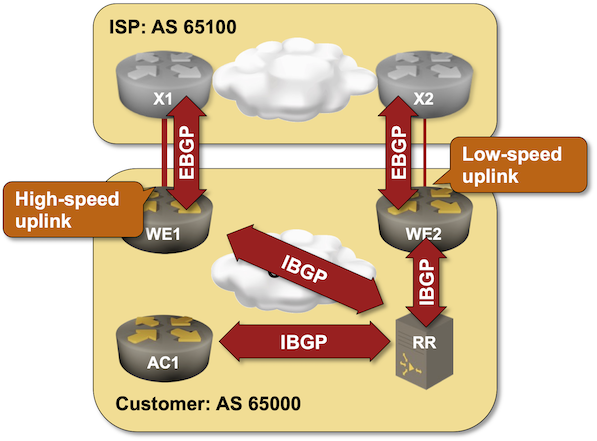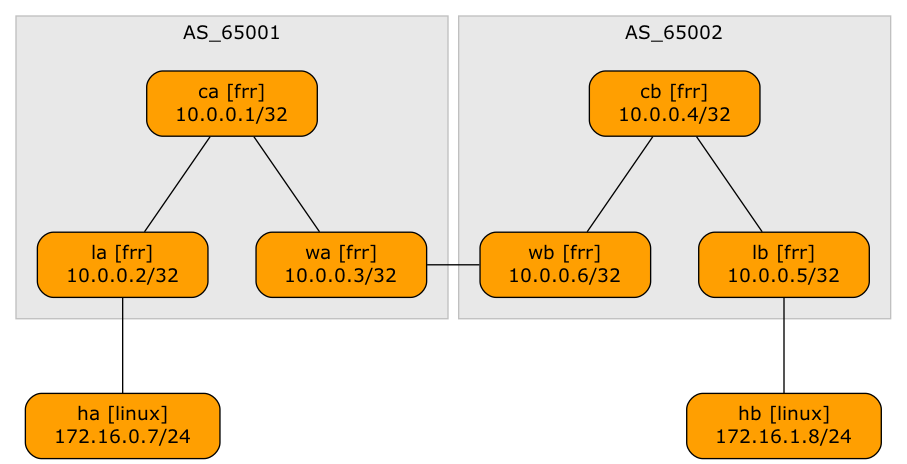Author Archives: Ivan Pepelnjak
Author Archives: Ivan Pepelnjak
Is it possible to deploy Precision Time Protocol across a country-wide WAN network and reach nanosecond-level synchronization between cities? It’s definitely not trivial and only works over dedicated infrastructure; for more details, watch the PTP in WANs (video) presentation Oliver Ettlin had at SwiNOG 40.
Last week, I explained how to generate network topology graphs (using GraphViz or D2 graphing engines) from a netlab lab topology. Let’s see how we can make them look nicer (or at least more informative). We’ll work with a simple leaf-and-spine topology with four nodes1:
defaults.device: frr
provider: clab
nodes: [ s1, s2, l1, l2 ]
links: [ s1-l1, s1-l2, s2-l1, s2-l2 ]
This is the graph generated by netlab create followed by dot graph.dot -T png -o graph.png:
When I was writing a blog post, I needed a link to the netlab lab topology documentation, so I searched for “netlab lab topology” (I know I’m lazy, but it felt quicker than navigating the sidebar menu).
The AI overview I got was way too verbose, but it nailed the Key Concepts and How It Works well enough that I could just use them in the netlab README.md file. Maybe this AI thing is becoming useful after all ;)
I wrote about the optimal BGP path selection with BGP additional paths in 2021, and I probably mentioned (in one of the 360 BGP-related blog posts) that you need it to implement IBGP load balancing in networks using BGP route reflectors. If you want to try that out, check out the IBGP Load Balancing with BGP Additional Paths lab exercise.

Click here to start the lab in your browser using GitHub Codespaces (or set up your own lab infrastructure). After starting the lab environment, change the directory to lb/4-ibgp-add-path and execute netlab up.
I always ask engineers reporting a netlab bug to provide a minimal lab topology that would reproduce the error, sometimes resulting in “interesting” side effects. For example, I was trying to debug a BGP-related Arista EOS issue using a netlab topology similar to this one:
defaults.device: eos
module: [ bgp ]
nodes:
a: { bgp.as: 65000 }
b: { bgp.as: 65001 }
Imagine my astonishment when the two switches failed to configure BGP. Here’s the error message I got when running the netlab’s deploy device configurations Ansible playbook:
During integration testing, I find unexpected quirks in network devices way too often. However, that’s infinitely better than experiencing them in production (even after thoroughly testing stuff) while discovering that your peers don’t care about routing security, RPKI, and similar useless stuff.
For example, what happens if you define a new Routing Control Function (RFC) on Arista EOS and apply it to BGP routing updates in the same configuration session? You’ll find out in the Sorry We Messed Up (video) presentation Stefan Funke had at SwiNOG 40 (note: the bug has been fixed in the meantime).
netlab release 25.09 introduced numerous graphing enhancements and a new graph type (IS-IS graphs), so I decided to write a series of blog posts explaining how you can generate graphs from netlab lab topologies.
I wrote an intro to netlab topology graphs years ago, and as expected, it was hopelessly outdated, so I started the project with a complete overhaul of that article.
On September 9th, the ansible release 12.0 appeared on PyPi. It requires ansible-core release 2.19, which includes breaking changes to Jinja2 templating. netlab Jinja2 templates rely on a few Ansible Jinja2 filters; netlab thus imports and uses those filters, and it looks like those imports pulled in the breaking changes that consequently broke the netlab containerlab configuration file template (details).
netlab did not check the Ansible core version (we never had a similar problem in the past), and the installation scripts did not pin the Ansible version (feel free to blame me for this one), which means that any new netlab installation created after September 9th crashed miserably on the simplest lab topologies.
This is the workaround we implemented in netlab release 25.09-post1 (released earlier today):
IS-IS does not use IPv4 or IPv6, so it should be a no-brainer to run it over IPv4 unnumbered or IPv6 LLA interfaces. The latter is true; the former is smack in the middle of the It Depends™ territory.
Want to know more or test the devices you’re usually working with? The Running IS-IS Over Unnumbered/LLA-only Interfaces lab exercise is just what you need.

Click here to start the lab in your browser using GitHub Codespaces (or set up your own lab infrastructure). After starting the lab environment, change the directory to basic/7-unnumbered and execute netlab up.
Since time immemorial, I have used the ip host router configuration command to get host-to-IP mappings in networking labs without going through the hassle of setting up a DNS server. Some devices even accepted multiple IP addresses in the ip host command, allowing you to list all router interfaces in a single command and get reverse (IP-to-host) mapping working like a charm. Or so I thought 🤦♂️
It turns out I’m too old, and what I know is sometimes no longer true. It seems that the last implementation working as I expected is Cisco IOS Classic ☹️
It’s been over four years since I published the last Software Gone Wild episode. In the meantime, I spent most of my time developing an open-source labbing tool, so it should be no surprise that the first post-hiatus episode focused on a netlab use case: how Ethan Banks (of the PacketPushers fame) is using the tool to quickly check the technology details for his N is for Networking podcast.
As expected, our discussion took us all over the place, including (according to Riverside AI):
Whenever you see Gerhard Stein and Thomas Weible from Flexoptix in a list of presenters, three things immediately become obvious:
Their SwiNOG 40 presentation (video) met all three expectation. We learned how well transceivers cope with high temperatures and what happens when you try to melt them with a heat gun.
netlab release 25.09 includes:
But wait, there’s more (as always):
TL&DR: Over 3000
A few weeks ago, Christian opened an issue describing how netlab breaks when the lab topology has more than 250 devices. We fixed that, only to get into another morass: some code has complexity higher than O(n) (meaning that going from 100 to 200 devices makes things more than twice as slow). Christian is working on one of those problems at the moment (it’s not that his ginormous labs won’t start, it just takes a long time), and I decided it’s time to polish a few other bits of the code.
If you know as much about submarine cables (the thingies that carry 90% of international Internet traffic) as I do (= nothing), you SHOULD watch the Technical Update on Submarine Cables (video) presentation Liam Taylor had at the SwiNOG 40 event. Have fun ;)
Suresh Vina published a great netlab tutorial, going from the very basics to a full-blown MPLS network with custom multi-vendor device configuration. Thank you!
In the previous blog post on this topic, I described the iBGP local-as functionality and explained why we MUST change the BGP next hop on the routes sent over the fake iBGP session (TL&DR: because we’re not running IGP across that link).
That blog post used a simple topology with three routers. Now let’s add a few more routers to the mix and see what happens.
In early August, William Collins invited me to chat about a sarcastic comment I made about a specific automation tool I have a love-hate relationship with on LinkedIn.
We quickly agreed not to go (too deep) into tool-bashing. Instead, we discussed the eternal problems of network automation, from unhealthy obsession with tools to focus on point solutions while lacking the bigger picture or believing in vendor-delivered nirvana.
The we should give different applications different paths across the network idea never dies (even though in many places the residential Internet gives you enough bandwidth to watch 4K videos), and the Leveraging Intent-Based Networking and SRv6 for Dynamic End-to-End Traffic Steering (video) by Severin Dellsperger was an interesting new riff on that ancient grailhunt.
Their solution uses SRv6 for traffic steering1, an Intent-Based System2 that figures out paths across the network, and eBPF on client hosts3 to add per-application SRv6 headers to outgoing traffic.
A netlab user wanted to explore a multi-site design where every site runs an independent EVPN fabric, and the inter-site link is either a layer-2 or a layer-3 interconnect (DCI). Let’s start with the easiest scenario: a layer-3 DCI with a separate (virtual) link for every tenant (in the MPLS/VPN world, we’d call that Inter-AS Option A)

Lab topology